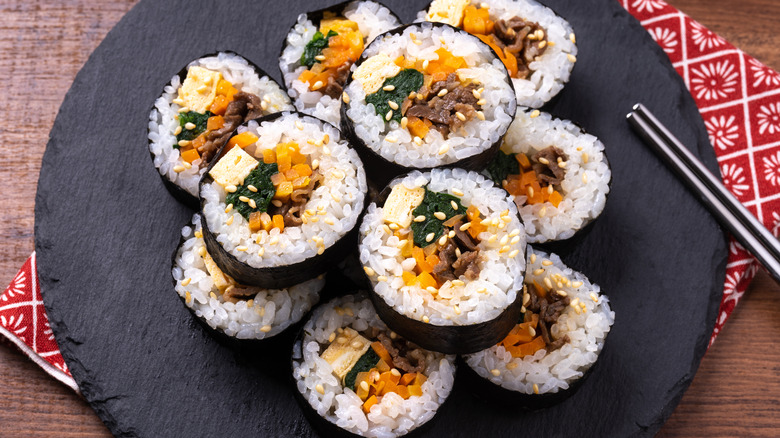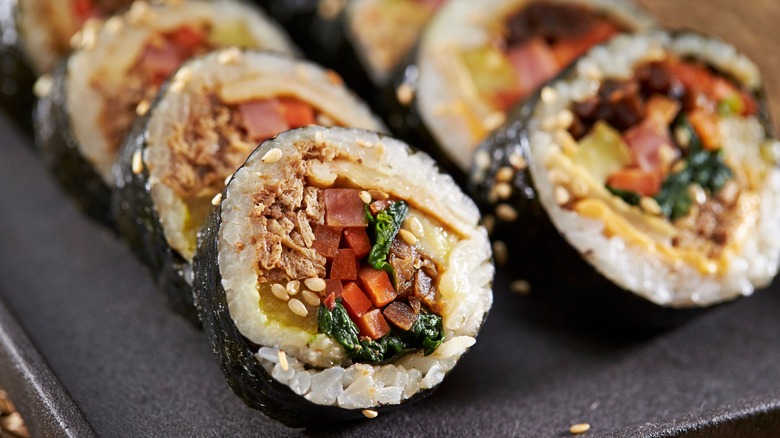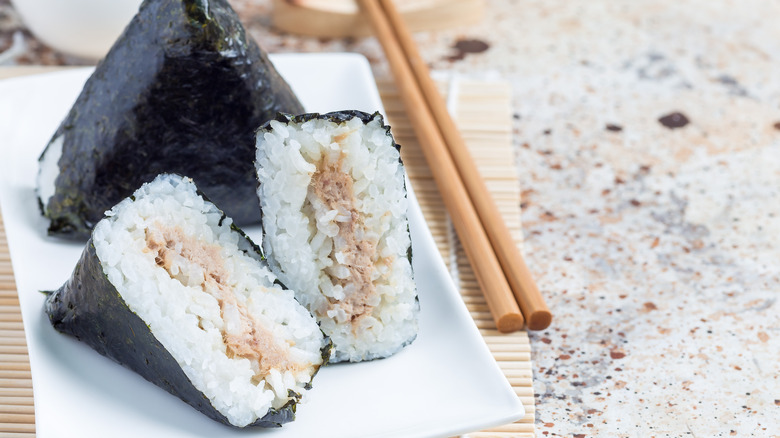Get To Know Korean Kimbap
To the untrained eye, pieces of sticky rice wrapped in seaweed and stuffed with ingredients other than raw seafood might easily be mistaken for a type of sushi, such as a veggie-stuffed futomaki roll. However, it might be kimbap. Often mistaken for the Korean version of Japanese sushi, kimbap is an entirely distinct dish with its own unique identity. The name comes from the Korean words for seaweed (kim) and rice (bap).
Unlike sushi, which uses vinegar to season the rice, kimbap relies on sesame oil, sesame seeds, and salt for flavoring the rice (bap). The rice used in kimbap is sticky enough to hold the fillings but not so much that it becomes gummy. It's seasoned with just enough sesame oil to give the rice a nutty flavor, without leaving a lingering greasy aftertaste.
Kimbap's fillings are also distinct. While raw seafood often stars in sushi, kimbap tends to feature cooked proteins such as imitation crab meat, beef bulgogi, pressed fish cakes (eomook), and omelets, along with vegetables like carrots, spinach, and pickled radish (danmuji). It's also not uncommon to find kimbap with cheese, ham, or kimchi. Each filling is usually prepared individually before being assembled into a roll with rice and seaweed, ensuring the final dish is a complex and flavorful blend of its various components. Unlike sushi, kimbap does not come with wasabi or pickled ginger. Instead, it utilizes kimchi as its palate cleanser.
The origin of kimbap
Despite the visual similarities between the two dishes, the comparison of kimbap with sushi can irk many. In fact, the question of which came first — kimbap or sushi — is a topic of debate in both Korea and Japan.
Some historians argue that sushi's history dates back to the second century with an ancient version called narezushi, where fermented rice was used to store salted fish. Historic texts indicate that nazerushi evolved into rolled sushi, or norimaki, during the Edo era in 1716. This form of sushi then allegedly entered Korea during the Japanese occupation, transforming into kimbap somewhere along the way. Interestingly, these supposed earlier versions of kimbap reportedly used vinegar and sugar to season the rice, much like Japanese sushi.
However, not everyone accepts the narrative that kimbap is a Koreanized version of sushi. Some argue that the practice of eating rice wrapped in dried seaweed is not unique to Japan and has its roots in Southeast Asia, existing for centuries. There are even mentions of seaweed production in Korea in 15th-century texts, which could suggest that Koreans had been eating rice wrapped in seaweed since the Joseon era, between 1392 and 1910, before Japan annexed Korea in 1910. Some theories also propose that Korea had already named and developed a dish made from rice wrapped in seaweed long before Japan did.
There are many types of kimbap
Regardless of its origin, kimbap is a staple in Korean households, where it is enjoyed in far more informal settings than sushi. This handheld finger food is a fitting snack for various occasions, including picnics, long car rides, sports games, and hikes. It can be bought at virtually any convenience store in Korea and eaten on-the-go.
Kimbap's variations can broadly be categorized into three main types: traditional, samgak, and nude. Traditional kimbap consists of rice, seaweed, and a variety of fillings, while nude kimbap has seaweed tucked inside, with rice forming the outermost layer (hence the term "nude"). Samgak kimbap — which is similar to Japanese rice balls and was introduced in the 1990s — is shaped into triangles and wrapped in plastic for convenient grab-and-go snacking. This type of kimbap is often stuffed with fillings like bulgogi and kimchi.
Within these three main categories, countless variations of kimbap exist. "Mayak" kimbap is left in a cylindrical roll and never sliced, whereas "chamchi" kimbap features tuna but with a greater filling-to-rice ratio. Some kimbaps are filled with cheese, others with pork cutlet, and still more with eggs or beef. There's even a version known as "chungmu" kimbap, made with nothing but good ol' kim and bap, often served with a side of radish salad and spicy squid for flavor.



